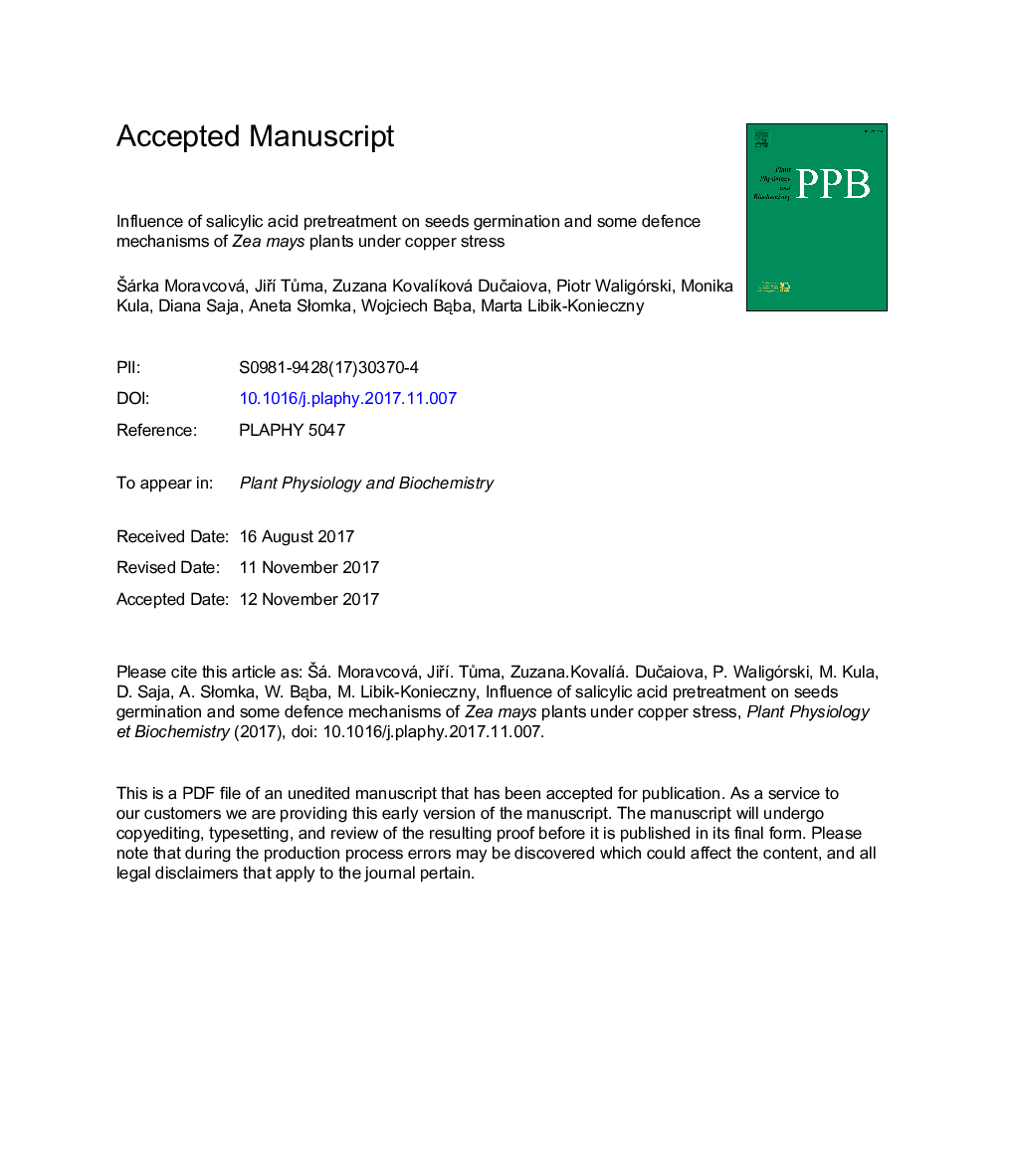| کد مقاله | کد نشریه | سال انتشار | مقاله انگلیسی | نسخه تمام متن |
|---|---|---|---|---|
| 8353590 | 1541899 | 2018 | 51 صفحه PDF | دانلود رایگان |
عنوان انگلیسی مقاله ISI
Influence of salicylic acid pretreatment on seeds germination and some defence mechanisms of Zea mays plants under copper stress
ترجمه فارسی عنوان
تأثیر پیش آزمون اولیه اسید سالیسیلیک بر جوانه زنی بذر و برخی از مکانیسم های دفاعی گیاهان زئومای تحت تنش مس
دانلود مقاله + سفارش ترجمه
دانلود مقاله ISI انگلیسی
رایگان برای ایرانیان
کلمات کلیدی
DABCATNBTMDA3,3′-diaminobenzidine - 3،3'-diaminobenzidineAntioxidants - آنتی اکسیدانNitro blue tetrazolium chloride - تترازولیم کلرید نیترو آبیMaize - ذرت یا جواریSOD - سدSuperoxide dismutase - سوکسوکس دیسموتازHeavy metals - فلزات سنگینmalondialdehyde - مالون دی آلدهیدfresh weight - وزن ترdry weight - وزن خشکCatalase - کاتالاز
موضوعات مرتبط
علوم زیستی و بیوفناوری
علوم کشاورزی و بیولوژیک
دانش گیاه شناسی
چکیده انگلیسی
The study was focused on the influence of salicylic acid (SA) on maize seeds germination and on some physiological and biochemical processes in maize plants growing in the hydroponic culture under copper (Cu) stress. A significant influence of SA pretreatment on the advanced induction of the maize seeds metabolic activity and the level of the endogenous SA in germinated seeds and developing roots have been stated. Although, the ability of maize seeds to uptake SA and accumulate it in the germinated roots was confirmed, the growth inhibition of Cu-stressed maize seedlings was not ameliorated by SA seeds pretreatment. Cu-stressed plants exhibited a decrease in the photosynthetic pigment concentration and the increase in non-photochemical quenching (NPQ) - an indicator of an excess energy in PSII antenna assemblies lost as a heat. The amelioration effect of SA application was found only for carotenoids content which increased in stressed plants. It was also shown that maize roots growing in stress conditions significantly differed in the chemical composition in comparison to the roots of control plants, but the SA pretreatment did not affect these differences. On the other hand, it was found that SA seed pretreatment significantly influenced the ability of stressed plants to accumulate copper in the roots. It was stated that a higher level of exogenous SA application led to a lower accumulation of Cu ions in maize roots. Cu-stressed plants exhibited higher oxidative stress in roots than in leaves which was manifested as an increase in the concentration of hydrogen peroxide due to stress factor application. We observed an increase in catalase (CAT) activity in leaves of Cu-stressed plants which corresponded with a lower H2O2 content when compared with roots where the hydrogen peroxide level was higher, and the inhibition of the CAT activity was found. Furthermore, we found that the SA seed pretreatment led to a decrease in the H2O2 content in the roots of the Cu-stressed plants, but it did not influence the H2O2 level in leaves. The increase in hydrogen peroxide content in the roots of Cu-stressed plants correlated with a higher activity of the MnSODI and MnSODII isoforms. It was found that SA pretreatment caused a decrease in MnSODII activity accompanied by the decrease in H2O2 concentration. Achieved results indicated also that the changes in the chemical composition of the root tissue under copper stress constituted protection mechanisms of blocking copper flow into other plant organs. However, it might be assumed that the root tissue remodelling under Cu stress did not only prevent against the Cu ions uptake but also limited the absorption of minerals required for the normal growth leading to the inhibition of the plant development.
ناشر
Database: Elsevier - ScienceDirect (ساینس دایرکت)
Journal: Plant Physiology and Biochemistry - Volume 122, January 2018, Pages 19-30
Journal: Plant Physiology and Biochemistry - Volume 122, January 2018, Pages 19-30
نویسندگان
Å árka Moravcová, JiÅà Tůma, Zuzana KovalÃková DuÄaiová, Piotr Waligórski, Monika Kula, Diana Saja, Aneta SÅomka, Wojciech BÄ
ba, Marta Libik-Konieczny,
